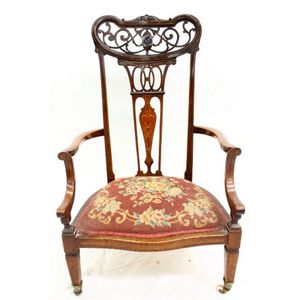Edwardian Mahogany Drawing Room Suite
You must be a subscriber, and be logged in to view price and dealer details.
Subscribe Now to view actual auction price for this item
When you subscribe, you have the option of setting the currency in which to display prices to $Au, $US, $NZ or Stg.
- Foliate - Decorated with leaves or leaf-like forms.
- Cabriole Leg - The cabriole leg evolved from an elongated scroll, curving out at the knee which may or may not be carved, and forming a serpentine shape as it descends to the foot.
First introduced into English furniture in the late 17th century, cabriole legs were widely used during the Queen Anne and early Georgian periods, where they frequently terminated in a pad foot or ball and claw foot. The style has had many imitators since then. The cabriole leg was re-introduced in the mid-19th century, and is commonly associated with the balloon-back dining or drawing-room chairs made in walnut, mahogany or, in Australia, cedar. The Victorian cabriole leg, on the whole, was rather more slender than the earlier form, following the French style, which emphasized the delicacy and daintiness of the chairs they were designed to support. Cabriole legs are sometimes found on windsor chairs, especially those made during the 18th century. - Pierced Decoration - Ornamental woodwork with part of the background cut through and removed to produce an open-work pattern.
- Mahogany - Mahogany is a dense, close grained red-coloured timber from the West Indies and Central America. It was first imported into Europe in the the early 18th century and its use continued through the 19th century. It was popular for furniture making because of its strength, the wide boards available, the distinctive grain on some boards, termed flame mahogany and the rich warm colour of the timber when it was polished.. The "flame" was produced where a limb grew out from the trunk of the tree, and this timber was usually sliced into veneers for feature panels on doors, backs and cornices.
Some terms used to describe mahogany relate to the country from which it originally came, such as "Cuban" mahogany, "Honduras" mahogany etc. However unless the wood has been tested the names assigned are more a selling feature, rather than a true indication of the timber's origin. - Edwardian - The Edwardian period of English furniture and decorative arts design is named for Edward VII (1841 ? 1910) who was King of the United Kingdom and the British Dominions and Emperor of India for the brief period from 1901 until his death in 1910. It follows the Victorian period, in turn was followed by the Art Nouveau and Art Deco styles. In Australia, designs of this period are also known as being in the Federation style.
- Thomas Sheraton - Thomas Sheraton (1751-1806) was born in Stockton on Tees in the north of England. He was apprenticed to a local cabinetmaker and after working as a cabinetmaker, Sheraton moved to London about 1790. Although he described himself as a cabinet-maker, like Chippendale, no definite piece of furniture can be traced to him as maker. Nevertheless, he was immensely influential and in 1791-4 published his four volume book 'The Cabinet-Maker and Upholsterer's Drawing Book'. The books were used as source of design by the furniture-making trade , who often simplified or modified the designs to suit their own preferences. Sheraton furniture is marked by restraint and sophistication, elegance and discretion, though he also found time to invent fanciful combination furniture.
- Circa - A Latin term meaning 'about', often used in the antique trade to give an approximate date for the piece, usually considered to be five years on either side of the circa year. Thus, circa 1900 means the piece was made about 1900, probably between 1895 and 1905. The expression is sometimes abbreviated to c.1900.
This item has been included into following indexes:
- seating, lounges, settees and suites
- settees and sofas
Visually similar items

A George III Sheraton mahogany elbow chair, with a pierced splat, with out swept arms, on square tapering legs

A Edwardian mahogany nursing chair, c.1910, with inlay and upholstered with tapestry, some minor fretwork damage, aged upholstered tapestry complete, white porcelain castors in tact, height 96 cm

Pair of French Louis XV style armchairs (2)

A late Victorian mahogany upholstered armchair, late 19th century, the button back chair with a showframe and a gently arched crest with small relief button rosettes, padded arms and turned supports, a generous stuffover seat and raised on turned legs term
